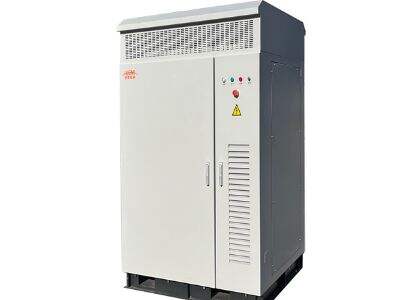الطاقة ضرورية في حياتنا اليومية. نعتمد عليها لتشغيل منازلنا ومدارسنا وحدائق اللعب والعديد من الأماكن الأخرى. هل فكرت يومًا في مصدر هذه الطاقة وكيف تصل إلينا؟ من المثير كيف أن كل شيء مترابط.
ولكن فقط من حيث أنها شبكة توزيع الطاقة. هذه الشبكة هي نظام كبير متصل، يربط بين إنتاج الكهرباء (في محطات الطاقة) والاستخدام النهائي (في المنازل والمدن) عبر خطوط نقل بعيدة. لكن أحيانًا نحتاج إلى كمية طاقة أكبر من المُنتجة. هنا يأتي دور تخزين طاقة الشبكة لإنقاذ الموقف.
تخزين طاقة الشبكة: هذه تقنية حكيمة تُخزن الكهرباء الزائدة عندما لا نحتاج إليها بشدة. على سبيل المثال، سيكون هناك أوقات خلال اليوم يستخدم الناس فيها طاقة أقل، مثل الفجر أو المساء. قد تنتج محطات الطاقة المزيد من الطاقة مما نحتاج إليه في تلك الأوقات. يقوم تخزين الطاقة في الشبكة بحفظ هذه الطاقة الثمينة حتى نحتاجها. ثم، في فترات الطلب المرتفع عندما يحتاج الكثير من الناس إلى الطاقة، مثل بعدnoons الصيف الحار عندما يشغل الجميع التكييف، تعود الطاقة المخزنة إلى الشبكة. هذا يعني أن هناك طاقة متاحة للجميع.
تُستخدم البيانات لتدريب النظام حتى أكتوبر 2023
إدارة الطاقة تتعلق باستخدام الطاقة بشكل ذكي وضمان وجود كمية كافية من الطاقة للجميع. الشبكة تخزين الطاقة على نطاق واسع تلعب دورًا مهمًا جدًا في هذا العملية. فهي تخزن الطاقة الزائدة التي تنتجها المصادر المتجددة مثل الألواح الشمسية التي تمتص ضوء الشمس والتوربينات الهوائية التي تستفيد من الرياح لإنتاج الكهرباء.
تخزين الشبكة يجعل الطاقة المتجددة تعمل بشكل أفضل لأن الشمس والرياح لا تكون دائمًا متاحة. بعض الأيام يكون الجو غائمًا أو هادئًا ولا نتمكن من إنتاج كمية كبيرة من الطاقة. باستخدام تخزين الشبكة، يمكننا الاحتفاظ بطاقة إضافية في الأيام المشمسة أو الريحية واستخدامها عندما يكون هناك طلب أكبر على الكهرباء. هذا يجعل الطاقة المتجددة أكثر موثوقية وجاذبية للمستثمرين الذين يرغبون في تمويل مشاريع الطاقة النظيفة.
لمستقبل أنقى: تخزين طاقة الشبكة
يسعى ISemi إلى المساهمة في جعل العالم أخضر وأكثر صحة للجميع. يعتمد هذا الهدف بشكل كبير على شبكة تخزين الطاقة الموزعة . فهو يحسن كفاءة الطاقة المتجددة ويقلل من اعتمادنا على الوقود الأحفوري، الذي يمكن أن يؤثر سلبًا على بيئتنا ويزيد من تغير المناخ. من خلال تبني المزيد من الطاقة المتجددة، يمكننا تنقية الهواء وحماية كوكبنا لأجيال المستقبل.
لذا نحن بحاجة الآن أكثر من أي وقت مضى إلى تخزين الشبكة. هذا صحيح ويجعله مفيدًا لإدارة التقلبات في إنتاج الطاقة بينما نستخدم المزيد من مصادر الطاقة المتجددة. على سبيل المثال، يشرق الشمس بقوة في يوم معين وتوفّر الألواح الشمسية كمية كبيرة من الطاقة، ولكن في اليوم التالي يكون هناك أمطار مما يؤدي إلى انخفاض كبير في إنتاج الطاقة. من خلال تخزين الطاقة النظيفة وإطلاقها عند الحاجة، يمكن للشبكة نظام تخزين طاقة موزع أن تجعلنا نعتمد أقل على مصادر الطاقة الملوثة، مما يحسن حالة عالمنا.
الحجة لصالح تخزين طاقة الشبكة
تخزين طاقة الشبكة ضروري لمستقبل توزيع الطاقة وهو حيوي لإدارة الطاقة. وهذا يتضمن توزيع الوصول إلى الطاقة للجميع.
مع زيادة الطلب على الطاقة، تأتي الحاجة إلى المزيد من التخزين لموازنتها. يساعد تخزين الشبكة في موازنة الطاقة أثناء الفترات الذروية، ويقلل من حصول انقطاعات الكهرباء، ويعمل على إدارة أفضل للشبكة. هذا مهم جدًا، لأن نقص الطاقة الكافية يمكن أن يؤدي إلى انقطاع التيار، مما يعني أن الناس لن يكون لديهم طاقة لأضواءهم، وأجهزتهم، وأجهزتهم الإلكترونية.
عن طريق تخفيف الضغط على الشبكة وتوفير الطاقة عند الحاجة إليها، فإن تخزين الشبكة هو ما يبقي نظام الطاقة لدينا سليمًا وموثوقًا حتى خلال الأوقات الصعبة عندما يرتفع الطلب.
بناء المرونة في نظام الطاقة الخاص بنا
تعرف ISemi على أهمية وجود نظام طاقة آمن في حياتنا اليومية. هناك العديد من الأشياء التي لن تعمل بدون طاقة. من خلال تخزين طاقة الشبكة، يمكننا جعل نظام الطاقة* لدينا أكثر مرونة أمام الصدمات مثل العواصف أو فشل البنية التحتية.
يمكن أن تُخزن الطاقة الزائدة في الأوقات الهادئة عندما لا نحتاج إلى الكثير منها، ونضمن توفر الطاقة في الأوقات التي نحتاجها حقًا. هذه الطاقة المخزنة هي المفتاح لتشغيل المرافق الأساسية مثل المستشفيات والمدارس والخدمات الطارئة، وتقلل من انقطاع التيار الكهربائي خلال الطوارئ. إنها نوع من الخطة الاحتياطية لضمان سلامة الجميع واستمرار توفير الطاقة.
تخزين الطاقة — بالنسبة للشبكة — هو العنصر الرئيسي في مستقبلنا الطاقي. فهو يساعد في توزيع الطاقة عالميًا، ويشرف على إنتاج الطاقة، ويجعل من الممكن استخدام مصادر الطاقة المتجددة، ويشكل استعدادًا لأي طارئ. تخزين طاقة الشبكة ضروري لتحقيق مستقبل طاقي أفضل وأكثر خضرة واستدامة للجميع في المستقبل القريب وفي السنوات القادمة.
شكرًا لك على التعلم مع ISemi حول الدور الهام لتخزين طاقة الشبكة. ولمستقبل مشرق ونظيف — معًا.

 EN
EN
 AR
AR BG
BG DA
DA NL
NL FI
FI FR
FR DE
DE EL
EL HI
HI IT
IT JA
JA NO
NO PL
PL PT
PT RO
RO RU
RU ES
ES TL
TL ID
ID UK
UK VI
VI TH
TH TR
TR AF
AF MS
MS BE
BE AZ
AZ BN
BN JW
JW KN
KN KM
KM LO
LO LA
LA MY
MY UZ
UZ KY
KY LB
LB XH
XH
